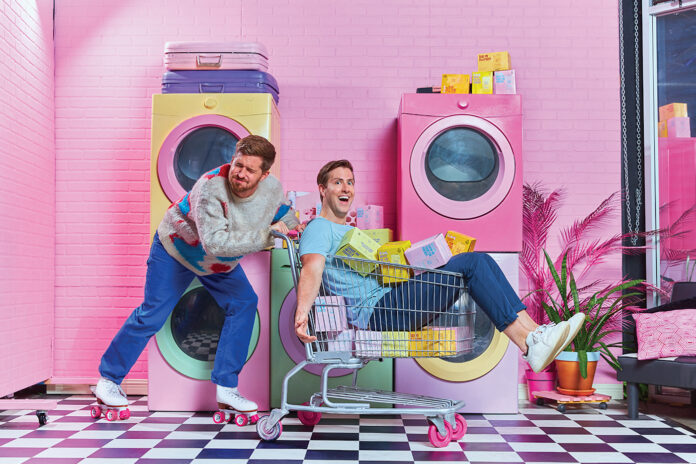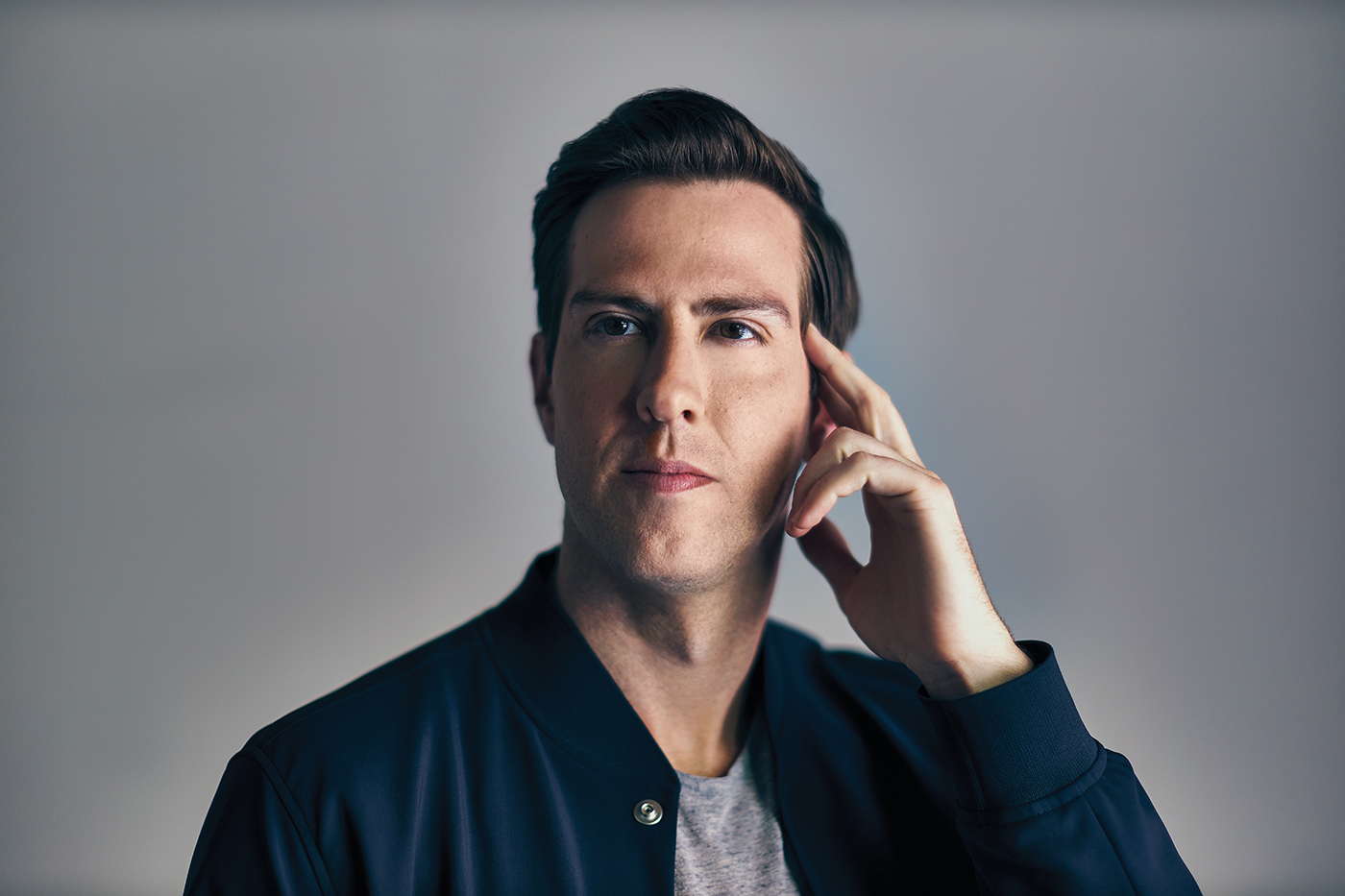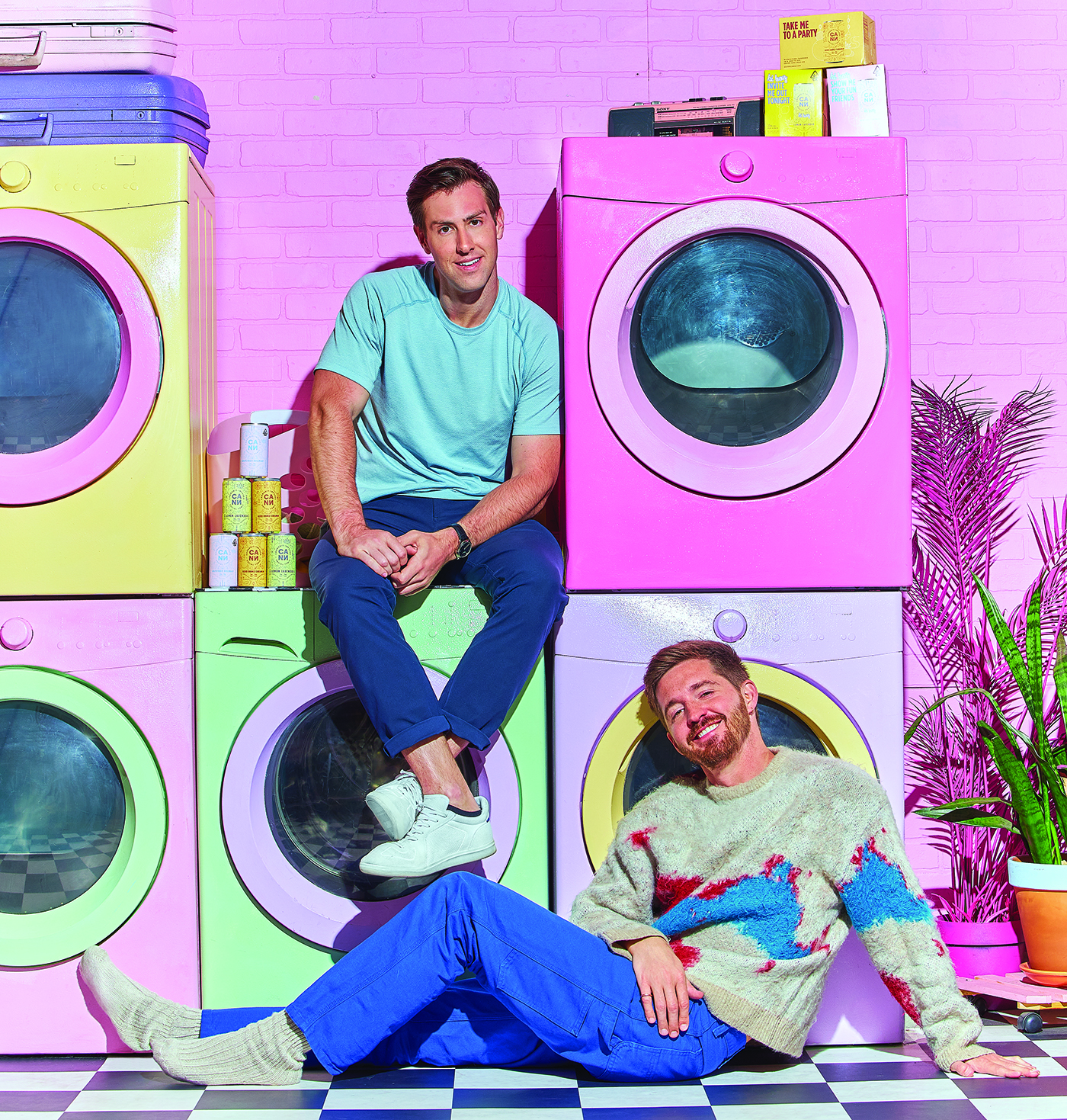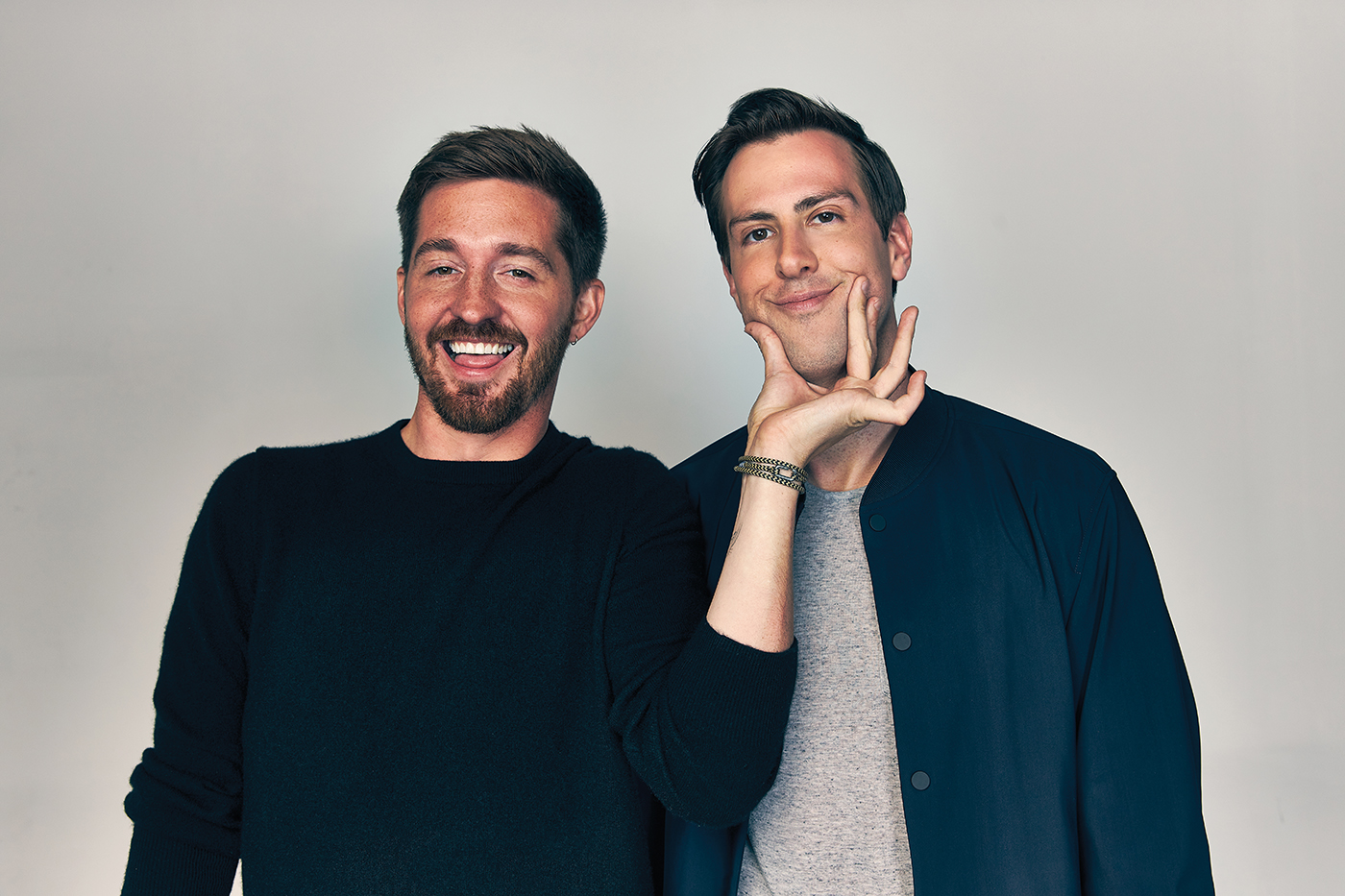
Perhaps more than any other consumer-packaged-goods form factor, the beverage category has a tendency to follow trends. The once-fringe sparkling water brand LaCroix capitalized on a trend away from sugary drinks by leaning into a kitschy “anti-Perrier” aesthetic and unorthodox flavors like Lemoncello and Cherry Blossom. LaCroix’s sudden surge in popularity opened the flavored seltzer category, which promptly became saturated with competitors and knock-off store brands.
In cannabis, Cann is the brand that disrupted beverages. In 2019, after identifying a market opportunity for low-dose drinks, Ivy League MBAs Luke Anderson and Jake Bullock conceived a product that became a catalyst for filling dispensary fridges across the country. To date, more than 10 million cans of the social tonic have been sold across six states and two Canadian provinces. Their process was intentional.
Cann was among the first to sidestep the milligrams-per-dollar value calculation on which its peers competed, turning its competitive attention to beverage alcohol instead. In that market, brand affinity, product quality, and overall experience, not potency, drive price. Anderson and Bullock also astutely observed American adults want to consume less alcohol, with as many as 28 percent trying to quit booze entirely, according to a consumer sentiment survey from NC Solutions. “At the end of the day, Cann is targeting unwanted alcohol consumption, and that means thinking beyond who is coming into dispensaries today,” said Anderson.
Vivid, quirky, and proudly queer, Cann has won numerous awards and reams of media coverage, courted more than forty celebrities as investors, and demonstrated a cannabis brand can bring new consumers into stores as long as it understands their needs and reservations. The brand’s success is seen as something of a bellwether in the industry—a sign increasing awareness and access could make a large swath of as-yet-unrealized consumers open to consuming THC.
To increase awareness and access, the company has raised more than $40 million from some of the industry’s most prominent funds, as well as reputable venture capital funds outside the industry who count Cann as their only cannabis bet. Yet, despite the considerable investment and widespread enthusiasm for beverages, the category has yet to hit one percent of total sales on business-to-business wholesale marketplace LeafLink and makes up just 1.5 percent of sales in Cann’s home state of California, according to data platform Headset. Nevertheless, Cann’s competitors for the scant low-dose dollars are considerably more numerous today than when the brand launched, and each one benefits from the extensive marketing investment Cann has made to kickstart the category.

With no federal legalization in sight and an industry-wide cash crunch, the timeline for Anderson and Bullock’s vision of microdose beverages going toe to toe with beer and wine looks decidedly less specific than when their brand launched. But unpack the story, strategy, and driving purpose behind one of the hottest brands in the industry, and you’ll find ample reason to believe Anderson and Bullock have the smarts and vision to continue moving forward.
The opportunity
Like many of us, the twenty-something versions of Anderson and Bullock liked to party. The pair met while working at prestigious global management-consulting firm Bain & Company, which advises Fortune 500 companies about issues including corporate strategy, finance, and operations. Bullock and Anderson often turned to alcohol to help them cope with their high-stress jobs and the quiet agony of being “in the closet.”
“When we first met in 2012, we were both straight,” said Anderson. “We were drinking a ton as a way to cope with our queer identity crises.”
The hangovers got worse with time and, as an entrepreneurial project for his Master of Business Administration at Stanford, Bullock developed an idea for a low-dose cannabis-based alternative to alcohol. Being from Colorado, he was familiar with the industry and had observed the infused beverages of the day were high-dose and positioned like any other infused product.
“One of the ways we were taught to think about business is to think about analogs,” he said. “Our most common mild intoxicants are alcohol and caffeine. How do we consume those products? We drink them in incremental microdoses.”
“That was the thing that went off in my brain,” he continued. “There’s a reason beer is 5 percent [alcohol by volume] on average—because of the time it takes the body to metabolize that intoxicant.”
He and Anderson had blue-skied a cannabis beverage idea years earlier in the fog of a hangover, and Bullock brought it back up to see whether Anderson was interested. “I loved the idea,” said Anderson. “So I suggested we commit to doing a three-month project, build a pitch deck, make a prototype, and try to raise a million bucks. And if we could do that, we’d launch the business.”
A whirlwind trip around the venture capital circuit yielded a lot of skepticism at first. “Lots of nos,” Anderson said, laughing. “Some people thought we were too early, others thought we were actually too late. One even offered us $2 million if we did CBD only.”
They pulled in around $300,000 from friends and family before Sean Stiefel, founder and chief executive officer at Navy Capital, pledged the first big check: $700,000. That pushed the campaign over the threshold.
“I was incredibly impressed with Luke and Jake. They had excellent backgrounds, and I could tell they had immense passion for building Cann,” said Stiefel. “We felt confident leading the round, because we believed in the team and the form factor and wanted to make a significant enough investment where we would see a material benefit from our involvement.”

Bullock and Anderson closed the seed round at $1.6 million and promptly moved to Venice Beach, California, where they holed up in a room above a garage for six months to work out how they would make Cann work.
“The biggest challenges we had to solve were how do you actually make the product? How do you get two milligrams of THC consistently into a canned beverage?” Bullock recalled. “And then there’s all sorts of complexity around the emulsion technology and the interactions it has with the packaging.”
Introducing innovative form factors or novel manufacturing approaches in cannabis remains challenging. When the pair began exploring the opportunity, there were no canned infused beverages, so a significant portion of their initial capital raise was spent standing up a manufacturing process.
“Five years ago, there was not a very evolved co-packer ecosystem,” explained Bullock. “Beverages really had not evolved at that point, especially canned beverages, which are much more difficult to manufacture than bottles.”
While they labored to overcome the manufacturing challenges, they began pre-launching the product, giving out free unmedicated samples and teasing the brand with bandanas—dubbed “Canndanas”—at Coachella.
Initially, Cann was met with confusion from dispensary buyers, who believed no one would pay a premium price for products with less THC. In fact, many brands were engaging in an unofficial arms race to deliver the highest potency. But Bullock and Anderson’s pitch asked buyers to consider consumers who weren’t visiting dispensaries because they were intimidated by 100mg edibles.
“We’re bringing new people into your store, and that’s part of how you’re going to grow and what this whole [legalization] experiment is about,” Bullock recalled explaining. “Why not figure out ways to broaden your customer base?”
MedMen was the first retailer to bite. At the time, the retailer was enjoying halcyon days as the dispensary for the cannacurious and one of the only brands known to a mainstream audience. The chain’s California stores sold all 3,000 cans of Cann’s initial product run in just four weeks and requested 30,000 more, putting the fledgling brand under considerable pressure to find a suitable manufacturing solution.
“If there was one thing I learned about [consumer packaged goods] at Bain, it’s that you have to be able to meet the needs of your retailers,” Anderson said. “If you don’t, they will go somewhere else, so we had to figure it out.”
The duo raised some fast capital from cannabis venture capitalist Gotham Green to cover the cash-flow issues that come with a sharp rise in demand and opted to focus their attention and efforts exclusively on MedMen for the first six months.
Gradually, buyers at other dispensaries began to embrace the idea of low-dose beverages as they saw the considerable traction starting at the highest-profile retailer in the country and heard the industry’s cries for stores to consider the mythical “cannacurious.”
Nothing spoke more directly to that consumer than Cann.

The branding process
From the moment of inception, Cann prepared for the day when cannabis beverages would be sold alongside beer and wine in stores like Whole Foods. Their experience at Bain left Anderson and Bullock with the knowledge a strong brand identity can be a major contributor to success.
“It’s so important that something looks undeniably ready for primetime before you commercialize it, because that helps with selling it to an investor, partner, or consumer,” said Anderson. “If the products look fantastic, the questions don’t come as frequently about whether or not they’re worth purchasing.”
After hiring and firing six different designers on their path to developing brand guidelines and the initial packaging mockups, Anderson and Bullock were introduced to edgy New York creative agency Red Antler.
“We dreamed about working with Red Antler after seeing what they did with Casper and Allbirds, but we knew we couldn’t afford them,” said Anderson.
Red Antler has helped develop now-famous products across a range of categories. By the time the team met with Cann, they had been approached by “dozens of cannabis opportunists,” according to partner and Chief Business Officer Blake Lyon. However, the agency saw “something different” in Anderson and Bullock. In addition, Lyon appreciated the brand’s disruptive mission.
“We meet with founders every single day to discuss their business vision and figure out how we can best bring a brand to life,” he said. “When we met Luke and Jake, it was the first time in two years I had met a cannabis team that closely resembled the type of high-energy, visionary founders we typically meet in the tech sector.”
The duo’s vision of selling their product in traditional retail and direct-to-consumer channels set them apart from other cannabis companies. “Cann saw themselves competing with a glass of wine or a can of beer,” Lyon said. “This was very novel to us.”
The agency’s executives were so impressed with the founders that they invested in Cann and set to work refining the existing brand and its packaging, bringing together the delightful line drawings and pastel tones into a harmonious balance that fizzed and popped with personality.
The emphasis on creating an outstanding brand from the get-go paid off with investors, particularly celebrities. Famous figures are notoriously image-conscious, and the kinds of celebrities Cann courted—Gwyneth Paltrow, Adam Devine, and Rosario Dawson, who sits on the company’s board—were not known cannabis consumers until Cann announced they had invested.
Cann sought the kind of mainstream celebrities who could be stand-ins for their ideal customers: those who wouldn’t be described as “stoners” but who would swap their nightly glass of wine or sleep aid for a tasty low dose of THC.
It’s impossible to imagine Paltrow opening her checkbook and attaching her name to a product covered in garish pot leaves or with a heady aesthetic. Discarding every cannabis visual and tonal trope and completely reimagining what a product might look like arguably was more important than the product itself. Image-conscious celebs deemed Cann’s brand “safe” for their brand. To date, the company has brought more than forty celebrities—or “talent partners,” as Anderson calls them—into the fold.
Swedish musician Tove Lo and actor DeVine have created their own flavors, former National Basketball Association star Baron Davis appeared alongside Kate Hudson in a Cann Christmas commercial, and the brand’s award-winning “Taste So Good” video campaign featured Patricia Arquette (more on that later).
All this celebrity buzz, coupled with unique product photography, has given the brand an unrivaled mainstream media salience and prompted features in the New York Times, Los Angeles Times, TechCrunch, and just about everywhere else that dedicates column inches to the intersection of cannabis and popular culture. Anderson estimates the value of the celebrity media coverage would exceed $100 million if Cann were to pay market rate for it, making the initial emphasis on brand and quality content seem like a stunningly savvy business decision.
The mission
While the product’s mission is to create a healthier alternative to alcohol, the brand’s mission, at least in part, is to normalize queerness and increase visibility of the lesbian, gay, bisexual, transgender, and queer (LGBTQ+) community through its advertising and marketing. “We set out to make something that appealed to everybody but had queerness and this idea of ‘otherness’ at the core,” said Anderson. “All of the marketing we’ve done, whether it’s the Pride campaign, a product launch, or a piece of social content, is done by being mindful of what it feels like to be marginalized.”
As founders of a prominent company, Anderson and Bullock believe they have a responsibility to support the LGBTQ+ community, particularly in a moment when trans people, non-binary people, and drag performers are facing intense persecution in some parts of the country. “Every queer-owned brand and every queer executive should be very vocally showing support for the people who are being attacked in society right now,” Anderson said. “Tim Cook, I’m looking at you, buddy. Give me a call!”
Cann’s founders see the brand’s content and advertising as a vehicle for normalizing queer visibility. In much the same way the brand has blazed a trail in the beverage category, it also has shouldered an outsized responsibility in spotlighting and supporting queer performers and artists. The brand’s voice is cheeky, bubbly, and brimming with irreverence and innuendo, much like one of the beloved drag queens who starred in the company’s groundbreaking marketing campaigns (which earned fifteen Clio awards in 2022 alone, including Brand of the Year).
“We care about positioning marginalized entertainers at the forefront of what we do, because when they’re visible, it becomes less scary to exist,” he continued. “We’re always going to support the creativity of queer people behind and in front of the camera and pay them what they deserve.”
While there is a perception that being mission-driven comes at the expense of financial performance (consider the snarky right-wing dictum “go woke and go broke”), for Cann, being proudly out and vocal has further endeared the brand to the mainstream media and prominent influencers. “You don’t need to follow the playbook of putting hot girls on Hummers to market your brand,” Anderson said. “You can deliver break-the-internet storytelling with a lower budget by paying queer people what they deserve to be paid and letting them do what they do.”
A case in point is the “Taste So Good (The Cann Song)” campaign, in which the brand commissioned a song and shot a high-profile music video featuring queer artists like Kornbread, Jorgeous, and Willow Pill. The video even featured a cameo from Sarah Michelle Gellar (Buffy the Vampire Slayer).
The infectiously catchy, saccharine pop jingle about a delicious cannabis drink is wildly different from anything a cannabis brand has done before or since. Production partner Weedmaps hosted the video on its YouTube channel, where more than half a million views make it the most popular offering. “It’s been streamed 2.5 million times on Spotify,” Anderson said, seeming genuinely surprised.
Some may consider commissioning a song and music video for a cannabis drink sold in a handful of states frivolous—after all, it’s pretty tough to draw a line from a Spotify stream to the sale of a single Cann—but Anderson swats away the notion as narrow thinking. Instead, he highlights the incalculable impact things like this have on the brand’s visibility and profile.
“It’s not driving sales, but it’s driving brand awareness,” he said. “If people see it in a bodega and remember the funky music video and think, ‘This is a brand that aligns with my values,’ that makes it easier for them to purchase it.”
The company’s mission to become a more diverse organization runs deeper than just high-profile talent partners. Cann publishes an annual accountability index with diversity, equity, and inclusion targets. In 2022, 25 percent of the company’s staff identified as Black, indigenous, or people of color (BIPOC), and the team donated almost $190,000 to organizations supporting equity and inclusion. However, Anderson worries maintaining the growth of diverse talent in the company’s ranks will take even more work in 2023, as many BIPOC and particularly women of color reportedly have departed the industry.
And yet, in a sector rife with big talk about social justice, Cann has proved to be a big walker. That makes a difference to the company’s investors. “They are a company that spends a lot of time talking about the world around them,” said Wendy Berger, an early investor and board member at Green Thumb Industries, one of Cann’s strategic partners. “I want to spend my money on companies that have value alignment. It’s incredibly important for the health of the industry.”
The competitive advantage
Cann now is in the challenging phase of maintaining its leadership position despite an onslaught of competition for the low-dose dollar trailing in its wake. Brands like Wunder, Wynk, Happi, and legacy beer brand Pabst all have thrown their hats in the ring, benefitting not only from Cann’s investment in category awareness but also the increase in facilities capable of making canned beverages and advances in water-soluble THC.
Despite the competition, there is ample reason to believe Cann will continue leading the pack for the foreseeable future. For one thing, Anderson and Bullock are prolific capital-raisers. Becoming a leader in the beverage category at this early stage means having a long runway, and Cann has managed to attract investment from a variety of sources inside and outside the industry—a significant advantage considering many venture funds today are mostly closed to new investments.
While Anderson believes his company was “too early” generally, he admits he and Bullock were lucky to be “a pair of white dudes with MBAs who were raising capital when there was a lot of money being thrown at the industry.” He expects to be cash-flow-positive by the end of 2024 but is quick to add becoming an outright category leader in traditional beverages takes considerably more capital. Given the regulatory challenges that obstruct cannabis companies’ ability to capture economies of scale, Anderson believes Cann’s performance to date is “really impressive.”
That said, chalking up Cann’s continuing leadership as the inevitable consequence of a significant war chest undersells the real reasons why the idea worked. A clearly positioned brand, a mission that meets the moment, and a diverse team with impressive pedigrees are major differentiating factors that will set Cann apart regardless of how numerous and well-funded the competition.
At the heart of the whirlwind are two very different men—friends who share an infectious passion for running a business that consistently has broken new ground and challenged the industry to follow every step of the way, even when the odds were stacked against them.
“Luke and I have been friends for more than a decade, and part of the reason we were comfortable starting this company together is we had done a lot of personal work in our friendship,” said Bullock. “We’ve been through it all: happy, angry, fighting, and resolving that conflict. We know one another very well now.”
Added Anderson, “We have been like two brains in different places who share the same overall objectives and thought patterns. There have been a lot of bumps in the road, but the fact we have been able to return to the partnership four and a half years in and operate from a place of mutual trust is what differentiates us from a lot of founder duos.”
We’ll drink to that.

Styling by Robert Sotello
